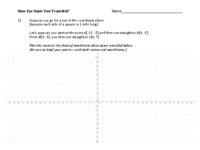
Distance in the Coordinate Plane (With Hints)
Discovery Lesson (Can be used without interactive figure below)
Polygons: Exterior Angles - REVAMPED
The exterior angles of a triangle, quadrilateral, and pentagon are shown, respectively, in the applets below. [br][br]You can control the size of a colored exterior angle by using the slider with matching color. [br]Feel free to move the vertices of these polygons anywhere you'd like. [br][br][b]Note:[/b] [br]For the [b]quadrilateral[/b] & [b]pentagon[/b], the last two applets work best if these polygons are kept [b]convex.[/b][br]If you don't remember what this term means, [url=https://www.geogebra.org/m/knnPDMR3]click here for a refresher[/url].
Exterior Angles of a Triangle
Exterior Angles of a Quadrilateral
Exterior Angles of a Pentagon
1.
What do you notice? What is common about the measures of the exterior angles of any one of these polygons?
2.
Do you think what you've observed for the triangle, quadrilateral, and pentagon above will also hold true for a hexagon, heptagon, and octagon? [br][br]Create a new GeoGebra file and do some investigating to informally test your hypotheses!
Quick (Silent) Demos
YOUR Linear Speed?
[b]Students:[/b][br][br]Use this applet to help you complete the [i][color=#0000ff]How Fast Are You Spinning?[/color] [/i]investigation given to you at the beginning of class. [br][br]Some key questions to consider are listed below the applet.
1.
According to NASA's website, what is the Earth's mean equatorial radius?
2.
According to your answer for (1), what would Earth's circumference be?
3.
What would the linear speed of a person who lives on the Equator be? (Round your answer to the nearest 10 miles per hour).
4.
What is YOUR current latitude? (For Southern Hemisphere users, use a negative number. For Northern Hemisphere users, use a positive number.) .
5.
Use your answer for (3) and your result for (4) to determine YOUR LINEAR SPEED in miles/hr. (Round to the nearest 10 miles per hour). For a hint, interact with the applet above.
Slope (Quiz) I
[b]Directions:[/b][br][br]1) In the applet below, [b]note the slope displayed.[/b][br]2) Drag one (or both) of the white points to move the line [b]so that this line has this slope.[br][/b][br]3) Click the [b]"Check Your Graph"[/b] checkbox to determine if you're correct. [br] If the slope of your line matches the slope displayed, you'll see a [color=#ff00ff][b][i]"CORRECT"[/i][/b][/color] sign appear. [br] If your line does not have the slope displayed, you'll see a [b]"Not Correct"[/b] sign appear. [br] If this happens, try again. If you need a refresher, [url=https://www.geogebra.org/m/Xutr9rPj]click here[/url]. [br]
Finsler-Hadwiger Action!!!
[color=#000000]In the applet below, simply slide the slider very slowly and enjoy the phenomena you witness. [br][br]After doing so, feel free to adjust the [b][color=#38761D]green [/color][/b]and [b][color=#BF9000]yellow[/color][/b] sliders to change the sizes of the [b][color=#38761D]green [/color][/b]and [b][color=#BF9000]yellow[/color][/b] squares, respectively. You can also change the locations of any of the white points. [br][br]Interact with this applet for a few minutes. Then answer the questions that follow. [/color][br][br]
Write the phenomena you've witnessed several times as a conditional ("if-then") statement.
Can you use coordinate geometry to formally prove what this applet informally illustrates? [br](For starters, why not let the common vertex be (0,0) and go from there?)
